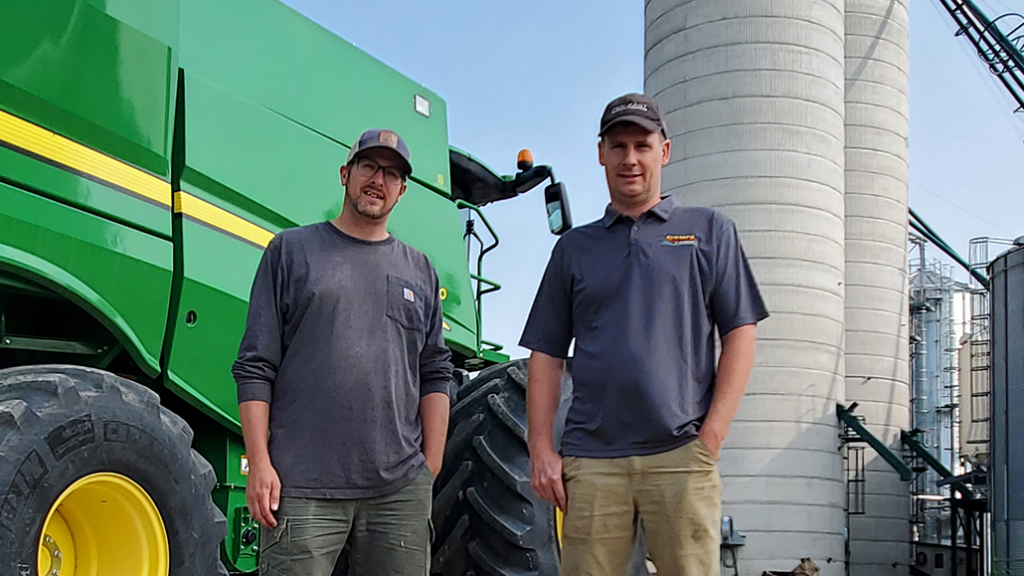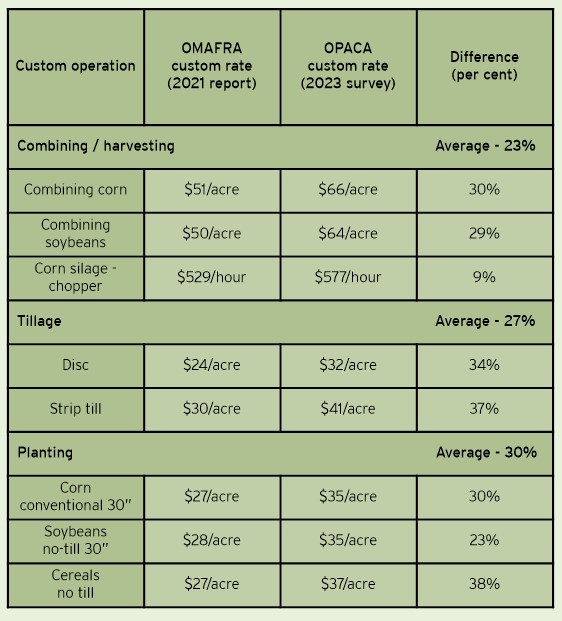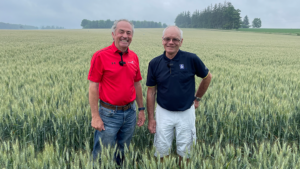Professional agri-contractors
CUSTOM FARMING SERVICES AND RATES ARE ON THE RISE

WHEN IT COMES to outsourcing fieldwork, Martin VanZandwyk says hiring a professional agri-contractor is a no-brainer. Not only does he have access to the latest planting and harvesting technology, but VanZandwyk is realizing higher crop yields and saving operating costs.
A Wellington County broiler, beef, and grain farmer, VanZandwyk grows 500 acres of corn, soybeans, wheat, and alfalfa. He used to manage his own fieldwork, working alongside his dad, but as his poultry and livestock responsibilities grew and field equipment breakdowns became more frequent, he quickly realized outsourcing some fieldwork made more sense.
“Today, I couldn’t pencil out the cost of running my own planting and harvesting equipment,” says VanZandwyk. “At the end of the year, my financial statements show I spend more on crop inputs than on custom operating. It’s very affordable.”
WORKING WITH PROFESSIONAL AGRI-CONTRACTORS
The affordability of working with a professional agri-contractor comes despite rising operational costs — something that is affecting all farmers. A recent interim survey conducted by the Ontario Professional Agri-Contractors Association (OPACA) found the average custom operating rate has increased by roughly 25 per cent since the latest Ontario Ministry of Agriculture, Food and Rural Affairs (OMAFRA) custom rates survey was released in 2022. Mark Luymes, OPACA director, explains that while the OMAFRA survey was conducted in 2021, the rising fuel and equipment prices meant the report was out-of-date even before its release.
“The challenge is that many farmers who hire custom operators and those who provide custom services rely on this benchmarking information to help inform and set rates,” explains Luymes, co-owner of Luymes Farms Ltd., a family run contracting business that works nearly 9,000 acres in Wellington and Perth counties, including Van Zandwyk’s. “That’s why OPACA did a ‘check in’ with members to determine more realistic rates that reflect the higher cost of doing business.”
In March 2023, OPACA asked 20 members to answer many of the same questions in the OMAFRA custom rates report. While the interim survey showed rates varied by business and equipment, the results revealed that the hike in all service fees across the province is a direct result of the surge in operational costs, including fuel, labour and equipment prices. Luymes says that while the member consultation was initiated as a response to the OMAFRA report, the organization will continue to work with the Ministry to conduct regular surveys and rate reports.
As expenses increase, Luymes reminds farmers to look beyond the numbers when working with a professional agri-contractor. Many contractors offer advantages of the latest technology, including row shut-offs and variable rate technology to establish uniformity and improve yield or tire inflation systems to reduce soil compaction. Contractors can also be viewed as an extension of a farm business team. All operators are trained and experienced, and many offer on-staff agronomists and mechanics to provide expert advice and service. Luymes explains many of his customers also rely on him for an extra set of eyes on their fields. And after covering thousands of acres each season, he is well-equipped to provide solutions and recommendations to help his customers troubleshoot concerns, realize their yield potential and enhance soil health. “We offer the whole package — complete farm care,” he says.
BUILDING TRUST AND BOOSTING THE BOTTOM LINE
Every farmer has been faced with increasing production costs, and in many cases, outsourcing field work makes financial sense now more than ever. “Especially for livestock farmers,” says Luymes, noting many OPACA members are geographically located in livestock-concentrated areas of the province. “Many customers focus their attention inside the barn and trust their fieldwork to us. Between production costs and labour shortages, farmers are increasingly relying on us to provide our expertise and technology to complement their farm operations.”
Like VanZandwyk, the average OPACA-member client might operate 500 acres or less. In many situations, these farmers have limited family or labour support or work off farm and rely on a contractor for help.
“I can’t even afford an older model combine or used equipment parts when I compare what I spend on custom operators,” says VanZandwyk, explaining that while cost is a factor in his decision to outsource planting and harvesting, he believes the agronomic advice and access to new equipment, like precision planters are the greatest advantages of working with a professional agri-contractor. VanZandwyk says he is seeing yield increases that can easily be attributed to the custom operator’s equipment and an increase in input efficiencies — both key factors that support his bottom line.
Handing over the responsibility of cropping and caring for the land can be challenging for some farmers. VanZandwyk admits it takes a different mindset and new communication skills. Like many who outsource services, he says his greatest challenge is not knowing when his contractor is coming, especially if the field is set to plant, rain is in the forecast, or the wheat is ready to be harvested. “Farmers aren’t patient, and it takes getting used to a new way of working; that’s why building trust and a relationship with your contractor is so important,” VanZandwyk explains. Working with two agri-contractors, one who manages his corn, wheat, and soybean acres and a second who takes care of his alfalfa, VanZandwyk has experience developing working relationships with each of them. Since VanZandwyk still manages his own tillage, fertilizer, and manure application, he relies on his grain crop contractor to build a customized cropping plan each year that accommodates the division of responsibilities. “We’re both invested in the success of my farm and once the plan is in place, we trust each other to manage our responsibilities,” says VanZandwyk.
THE LOWEST PRICE IS NOT ALWAYS THE BEST CHOICE
Luymes says combining is the most common service farmers outsource. Combines and harvesting equipment are also some of the most expensive equipment, making it an easy choice. Luymes recommends farmers considering outsourcing or looking for a professional agri-contractor start by asking for referrals rather than rates. “The lowest price isn’t always your best option. Building a relationship based on mutual goals and trust will be the greatest investment you can make in your fields,” says Luymes. Establishing clear expectations about the practices, technology, and machinery is also important when building a working relationship with a custom operator.
Established in 2017 to support and represent professional agri-contractors, OPACA membership continues to grow, especially as more farmers outsource their fieldwork. The organization roughly defines an agri-contractor as someone who makes 50 per cent or more of their business income as a custom operator. A founding member, Luymes says he’s noticed a trend of new, younger farmers seeing the growing demand for custom fieldwork and joining OPACA. “If you’re investing in a new piece of equipment, it makes sense to offer custom services to help pay for the machine. Contracting is a great way to build a business in agriculture that doesn’t require an existing land base or multi-generation family support,” he says.
Looking ahead, OPACA will continue to work with OMAFRA to keep tabs on the cost of doing business as a service to the industry. “Just like farmers evaluate their cost of production, we’re here to help everyone remain competitive, profitable and successful too,” says Luymes.

COMPARING CUSTOM FARMING RATES
In early 2023, the Ontario Professional Agri-Contractors (OPACA) conducted an interim custom farm rates survey of 20 members. The survey was based on questions asked as part of the Ontario Ministry of Agriculture, Food and Rural Affairs (OMAFRA) custom rates survey conducted in 2021 and released in 2022.
As a result of rising fuel and equipment costs, OPACA’s custom rates survey revealed farmers can expect a 25 per cent increase in OMAFRA’s reported contracting rates. Here is a look at a selection of OPACA’s survey results. Keep in mind that reported rates may vary based on geography, equipment and operators. •

























